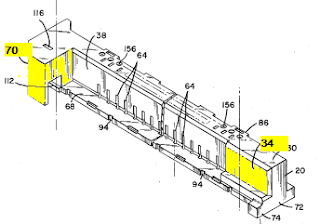Details:
Ex parte Smotkin
Appeal 2009011268, Appl. No. 09/891,200, Tech. Center 1700
Decided January 22, 2010
The claim at issue is reproduced below:
84. A proton-conducting membrane designed to serve as an electrolyte in a fuel cell, which membrane consists essentially of
a single metal or metal hydride support, wherein
one or both faces of said support is coated with an electronically-insulating proton-conducting coating, which coating consists of an inorganic material that contains no liquid phase, said coating having a thickness such that the ASR for protons at at least one temperature between 220°C and 550°C is in the range shown for Nafion® 117 in Figure 10:
In the Final Rejection, the Examiner rejected claim 84 as indefinite, citing to MPEP 2107(s):
Incorporation by reference to a specific figure or table "is permitted only in exceptional circumstances where there is no practical way to define the invention in words and where it is more concise to incorporate by reference than duplicating a drawing or table into the claim. Incorporation by reference is a necessity doctrine, not for applicant's convenience." Ex parte Fressola, 27 USPQ2d 1608, 1609 (Bd. Pat. App. & Inter. 1993) (citations omitted).
(Emphasis in original.)
The Examiner further explained that:
In this instance, it is pointed out that a first set of claims (i.e. claims 75-82) has been properly delineated and set forth without the use of said table/fimre. Accordingly, it is contended that is not imperative or necessary to specifically define the claimed subject matter by using the table/figure. The examiner is also concerned about the possibility that claim 84, as now amended, be technically inaccurate due to the use of a table/figure subject to multiple interpretations.
In the Appeal Brief, the Applicant noted a difference between claim 84 and the set of claims which did not use a figure:
[T]he range set forth in the graph of claim 84 is different from that mandated by claim 75; claim 75 mandates an area-specific resistance for protons (ASR) of 0.01-100 C2.cm2 whereas the range shown for NafionB in Figure 10 has a lower limit somewhat greater than 0.01 C2.cm2 and an upper limit clearly lower than 100 C2.cm2. As the figure is the only place where this range for NafionB is set forth in the specification, it is believed necessary to incorporate the figure into the claim in order to provide adequate support for this range.
(Emphasis added.)
The Applicant also distinguished Ex parte Fressola, arguing that Fressola involved an omnibus claim ("as disclosed in the specification and drawings herein") whereas the claim on appeal "sets forth the drawing and identifies the portion of the drawing that is relevant to the limitation of the claim."
The Board reversed the indefiniteness rejection:
In Ex parte Freessola we held that “[i]ncorporation into the claims by express reference to the specification and/or drawings is not permitted except in very limited circumstances.” Claim 84 "does not incorporate by reference a figure or table, it displays the figure and pinpoints the elements of the figure that relate to the limitations of the claim." (Appeal Brief 9.)
My two cents: The Board did not address the Examiner's concern with "use of a table/figure subject to multiple interpretations." Or the Applicant's characterization of Fressola as being about an omnibus claim rather than a figure in a claim. I checked out Fressola, and its facts really were about an omnibus claim: "as disclosed in the specification and drawings herein". But Fressola does contain a long discussion of other case law (going back to 1943) dealing with incorporation by reference of figures or tables.
The claim here literally included the figure, where Fressola prohibits incorporation of a figure by reference. But even if Fressola were applied here, it seems to me Fressola's exception might apply:
Incorporation by reference to a specific figure or table is permitted only in exceptional circumstances where there is no practical way to define the invention in words and where it is more concise to incorporate by reference than duplicating a drawing or table into the claim.





